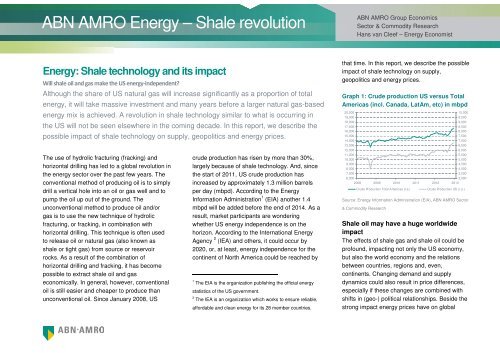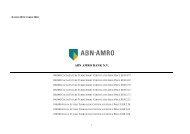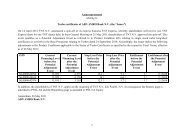ABN AMRO Energy Shale Report - ABN AMRO Markets
ABN AMRO Energy Shale Report - ABN AMRO Markets
ABN AMRO Energy Shale Report - ABN AMRO Markets
Create successful ePaper yourself
Turn your PDF publications into a flip-book with our unique Google optimized e-Paper software.
problems that the energy sector faces if shaleproduction continues to increase. Theseproblems include export restrictions,infrastructure issues, water use, qualitydifferences between shale oil and oil used by the(US) refineries, low natural gas prices andoversupply, among others.US shale oil: only limited local useDue to export restrictions, US refineries haveextra oil due to shale oil production. As a result,shale oil is stored for later use, which couldlower future imports for US refineries. Accordingto the IEA, however, many US refineries aregeared to process cheap, low-quality dense andhigh-sulphur grades of crude. Many shale oilrigs, however, produce lighter grades whichcannot be used by many US refineries.If US oil companies want to benefit from allshale findings, the US government needs toeither allow the export of lighter grades or furtherstimulate US refineries to reconfigure theirplants to handle the lighter grade crudeproduced from shale. If not, the US might as wellleave the remaining shale crude reservesuntouched.For the moment, imports of heavy grades fromother regions (mainly Canada) are still neededto meet US refinery demand, although importshave declined from a few years ago. Canadanow exports its remaining crude to Europe and,to a lesser degree, to Asia.More shale gas capacity, but many rigsclosed due to low pricesWith the success of US shale developments,many energy-related companies as well asinvestors and oil- and gas-rich states want tobenefit as well. A number of new drilling permitshave been issued and new rigs built. Especiallyfor shale gas, the number of rigs jumped higher.As a result, natural gas supplies have ballooned,leading to a huge drop in US Henry Hub naturalgasprices.The rise in the number of rigsdid increase productioncapacityWhile most commodities recovered significantlyafter the huge sell-off seen in 2008, natural-gasprices saw only two months of support beforepressure increased again in Q1 2010. Pricesremained under pressure and, even, touchedthe record low of USD 1.90 in April 2012,followed by a recovery towards the current priceof approximately USD 3.50.One reason for the price recovery is the closureof many US rigs brought about by low naturalgasprices, which made continued productionunprofitable. From a historical perspective,however, current prices are still very low, whileoversupply continues. The fact that supplies didnot decline is the result of an increase of byproduct(associated) gas from oil fields. For thecoming years, it should be understood that theincrease in the number of rigs, operational ornot, increases production capacity.Natural gas prices are now balancing athistorical low levels, responding to theimpact of moderate rising demand andan oversupply of rig-capacity. Thismeans that as soon as prices start torally based on increased demand, newproduction will come into play. Thisadditional production comes on top oflarge existing supplies.Table 2 <strong>ABN</strong> <strong>AMRO</strong> gas price forecast(in USD)Price 2013** 2014** 2015**US H.H.*Natural Gas 3.50 4.50 5.00* HH= Henry Hub 1st generic future contract** year averages,Source: <strong>ABN</strong> <strong>AMRO</strong> Sector & Commodity Research
As a result, the upside of natural gas pricesseems to be capped. In our view, the cap liesaround USD 5.50 for the coming few years,which is still significantly below historicalaverage levels.US shale versus European shaleThe drive for energy independence and aninterest in shale technology is not limited to theUS. While in Western Europe, heateddiscussions are still ongoing, Eastern Europe isincreasingly exploring options in unconventionalgas. The trend within Eastern Europe to breakaway from energy dependence on Russiacontinues. After Poland and Ukraine approvedshale gas exploration, the governments ofRomania and Lithuania followed. Actualproduction, however, still seems to be yearsaway. Not every country is interested, however.Bulgaria and the Czech Republic have bannedshale-gas production.Ongoing debates will preventshale technology frommaturing in EuropeThe British government ended the suspension ofthe controversial shale-gas extraction method inmid-December 2012. And Germany is keepingthe option open ahead of federal elections inSeptember. Gas prices in Germany are fourtimeshigher than in the US, partly as a result ofan extra premium which is charged on gasprices to stimulate green energy.Unconventional gas, such as shale, couldprovide some relief to natural gas prices whilestill avoiding banned nuclear-energy resources.Meanwhile, France and the Netherlands havemoratoriums on fracking. One of the reasonsthat the US maintains an economic benefit is thelack of a clear and aligned European policy onunconventional gas and oil production, asituation which prevents natural gas prices fromdropping significantly any time soon within theEU.Spread between US and European gas islikely to tightenIt appears that Russia will no longer link naturalgas prices to oil prices, upending a decadeslongpolicy, after Russia’s Gazprom revealedthat it will cut prices. As a result, the Europeangas market will be set more by actual naturalgas demand and supply, and not by a link to oilprices.With the combination of moderate risingdemand, price renegotiations with Russia andsteeper rising supply (mainly based onincreased shale production in parts of Europe),European natural gas prices are set to decline inthe years to come.Graph 3: Natural gas prices US Henry Hubversus Gas EU-NL TTF(in mmBtu/USD)1816141210864202007 2008 2009 2010 2011 2012Natural Gas (1st generic future) in mmBtu/USDGas EU-NL TTF in mmBtu/USDSource: <strong>ABN</strong> <strong>AMRO</strong> Sector & Commodity Research, ThomsonReuters EikonIn the US, Henry Hub natural-gas prices remainat historically low levels. The upside seems tobe capped by large inventories and the idea thatif prices rise too far, output will again be boostedby more rigs going into production.In this environment, we expect US natural gasprices to increase in the coming years, based ona modest rise in demand, while production, interms of both rigs and (shale) gas output, willgrow at a similar pace and result in some
Economisch Bureau | Sector & Commodity ResearchHans van Cleef<strong>Energy</strong> EconomistTel: +31 (0) 20 343 46 79hans.van.cleef@nl.abnamro.comDisclaimerThis document has been prepared by <strong>ABN</strong> <strong>AMRO</strong>. It is solely intended to provide financial and general information on the energy market. The information in this document isstrictly proprietary and is being supplied to you solely for your information. It may not (in whole or in part) be reproduced, distributed or passed to a third party or used for anyother purposes than stated above. This document is informative in nature and does not constitute an offer of securities to the public, nor a solicitation to make such an offer.No reliance may be placed for any purposes whatsoever on the information, opinions, forecasts and assumptions contained in the document or on its completeness, accuracy orfairness. No representation or warranty, express or implied, is given by or on behalf of <strong>ABN</strong> <strong>AMRO</strong>, or any of its directors, officers, agents, affiliates, group companies, oremployees as to the accuracy or completeness of the information contained in this document and no liability is accepted for any loss, arising, directly or indirectly, from any use ofsuch information. The views and opinions expressed herein may be subject to change at any given time and <strong>ABN</strong> <strong>AMRO</strong> is under no obligation to update the informationcontained in this document after the date thereof.Before investing in any product of <strong>ABN</strong> <strong>AMRO</strong> Bank N.V., you should obtain information on various financial and other risks and any possible restrictions that you and yourinvestments activities may encounter under applicable laws and regulations. If, after reading this document, you consider investing in a product, you are advised to discuss suchan investment with your relationship manager or personal advisor and check whether the relevant product –considering the risks involved- is appropriate within your investmentactivities. The value of your investments may fluctuate. Past performance is no guarantee for future returns. <strong>ABN</strong> <strong>AMRO</strong> reserves the right to make amendments to this material.© <strong>ABN</strong> <strong>AMRO</strong>, March 2013






